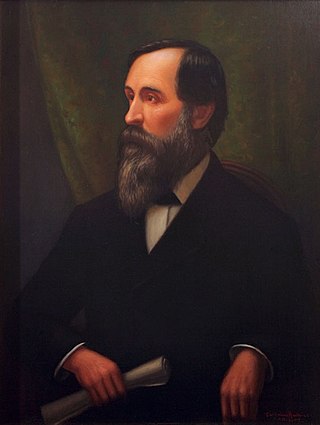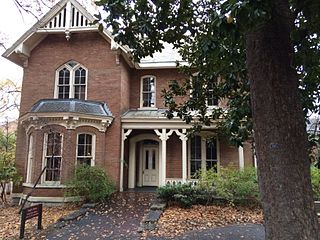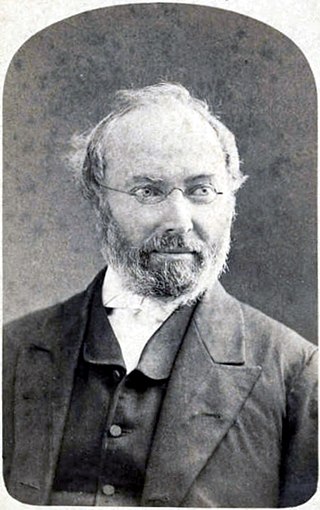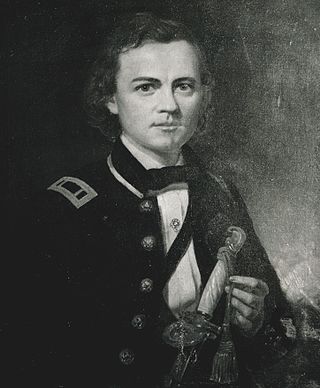
Frederick Augustus Porter Barnard was an American academic and educator who served as the 10th President of Columbia University. Born in Sheffield, Massachusetts, he graduated from Yale University in 1828 and served in a succession of academic appointments, including as Chancellor of the University of Mississippi from 1856 to 1861. He assumed office as President of Columbia University in 1864, where he presided over a series of improvements to the university until his death in 1889. He was also known as an author of academic texts.

Edward Emerson Barnard was an American astronomer. He was commonly known as E. E. Barnard, and was recognized as a gifted observational astronomer. He is best known for his discovery of the high proper motion of Barnard's Star in 1916, which is named in his honor.

Landon Cabell Garland (1810–1895), an American, was professor of physics and history and university president three times at different Southern Universities while living in the Southern United States for his entire life. He served as the second president of Randolph–Macon College in Ashland, Virginia, from 1836 to 1846; then professor from 1847 to 1855, and then third president of the University of Alabama in Tuscaloosa, Alabama, from 1855 to 1867; and first chancellor of Vanderbilt University in Nashville, Tennessee, from 1875 to 1893. He was an apologist for slavery in the United States before the Civil War, but afterward became a vociferous spokesperson against slavery.
University of Nashville was a private university in Nashville, Tennessee. It was established in 1806 as Cumberland College. It existed as a distinct entity until 1909; operating at various times a medical school, a four-year military college, a literary arts college, and a boys preparatory school. Educational institutions in operation today that can trace their roots to the University of Nashville include Montgomery Bell Academy, an all-male preparatory school; the Vanderbilt University Medical School; Peabody College at Vanderbilt University; and the University School of Nashville, a co-educational preparatory school.

John Berrien Lindsley (1822–1897) was an American Presbyterian minister and educator in Nashville, Tennessee.
Maurice Garland Fulton was an American historian and English professor. He was a professor of English and History at the New Mexico Military Institute for three decades. He was the (co-)author or (co-)editor of several books, and "an authority on the Lincoln County War and Southwestern history."

The Gorgas–Manly Historic District is a historic district that includes 12 acres (4.9 ha) and eight buildings on the campus of the University of Alabama in Tuscaloosa, Alabama. The buildings represent the university campus as it existed from the establishment of the institution through to the late 19th century. Two buildings included in the district, Gorgas House and the Little Round House, are among only seven structures to have survived the burning of the campus by the Union Army, under the command of Brigadier General John T. Croxton, on April 4, 1865. The other survivors were the President's Mansion and the Old Observatory, plus a few faculty residences.

William Leroy Broun was the President of the Agricultural and Mechanical College of Alabama, then known as the Alabama Polytechnic Institute, now known as Auburn University, from 1882 to 1902, with a one-year hiatus in 1883.
George Blackmore Guild (1834-1917) was an American Democratic politician. He served as the Mayor of Nashville, Tennessee from 1891 to 1895.

William S. Vaughn (1903–1996) was an American businessman and philanthropist. He served as the President of Eastman Kodak from 1960 to 1967, and as its Chairman from 1967 to 1970.

Nathaniel Thomas Lupton was an American chemist and university professor. He served as the President of the University of Alabama from 1871 to 1874. Additionally, he served as State Chemist of Alabama.
Milton W. Humphreys was an American Confederate sergeant during the American Civil War of 1861-1865 and an early scholar of Ancient Greek and Latin in the United States. He was the first professor to introduce the Roman pronunciation of Latin in the United States while teaching at Washington and Lee University. Additionally, he was the first Professor of Latin and Greek at Vanderbilt University and the University of Texas at Austin. He spent the rest of his career at the University of Virginia. He also served as the President of the American Philological Association in 1882–1883.

Thomas OsmondSummers was an English-born American Methodist theologian, clergyman, hymnist, editor, liturgist and university professor. He is considered one of the most prominent Methodist theologians of the nineteenth century.

Thomas H. Malone (1834-1906) was an American Confederate veteran, judge, businessman and academic administrator. He served as the President of the Nashville Gas Company from 1893 to 1906. He served as the second Dean of the Vanderbilt University Law School from 1875 to 1904.

Abner Edwin Patton was an American lawyer and Confederate soldier best known as a founder and the first president of Sigma Alpha Epsilon fraternity.
For the Missouri politician, see Robert A. Young.
Bishop William May Wightman (1808–1882) was an American educator and clergyman. He served as the President of Wofford College from 1853 to 1859. He served as the Chancellor of Southern University in Greensboro, Alabama from 1860 to 1866. He became a Bishop of the Methodist Episcopal Church, South in 1866.

William Harold Payne (1836–1907) was an American educator and translator. As professor of the Science and Art of Teaching at the University of Michigan in 1879, he was the first university professor of pedagogy in the United States. He served as the chancellor of the University of Nashville and the president of Peabody College from 1887 to 1901.

Thomas L. Maddin (1826–1908) was an American physician. He treated black slaves in Alabama in the antebellum era. He served as the director of a hospital for the Confederate States Army in Nashville, Tennessee during the American Civil War. He was a professor of medicine at the University of Nashville and the Vanderbilt University School of Medicine.

Major Samuel Hollingsworth Stout was an American farmer, slaveholder, teacher and surgeon. In the Antebellum era, he was the owner of a farm with slaves in Giles County, Tennessee. During the American Civil War, he was a surgeon to the Army of Tennessee and later in charge of sixty hospitals for the Confederate States Army in Georgia, Alabama, and Mississippi. He later taught at the Atlanta Medical College, and he practiced medicine in Texas. He was a co-founder and the founding dean of the Baylor College of Medicine in 1902-1903.















